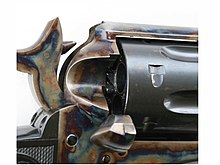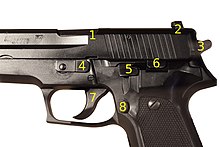Firearms security
Firearm safety is a technical precaution in a firearm that is intended to prevent an unintentional discharge of a shot . The safety features differ depending on the type of weapon (e.g. revolver or automatic firearm ) and the specific model.
The legal regulations for firearms security are different. For example, while the German Arms Act does not regulate this, some states in the United States , particularly California , have explicit legal regulations.
Trigger guard
The trigger guard protects the trigger tongue against unintentional contact and thus against unintentional firing.
Trigger weight
With the trigger weight, every trigger has a resistance that has to be overcome in order to trigger a shot. For utility weapons it is usually 20–30 N , in double action mode up to 70 N. For sports weapons that are only used at the shooting range , the trigger weights are significantly lower.
Manual backup

A manual safety device blocks the trigger path. It can act on different parts of the trigger such as the trigger tongue, the trigger rod or the striking device . The closer the fuse works to the cartridge, the more reliable it also works as fall protection. Modern weapons therefore secure the striking device (striking piece, bolt or pin).
A manual backup can be activated and deactivated using various operating concepts, e.g. B. a wing, lever, sliding or rotating element. The lettering is often S or F for Safe / Safe or Fire / Fire. Sometimes a red marking also signals readiness for fire.
In many fully automatic firearms, the safety lever is combined with the fire selector lever. Another variant is to use the same control element as a release lever so that the impact device is automatically released when you secure it.
Trigger lock

The trigger safety is an additional lever that is integrated into the trigger blade. The finger must be placed on the trigger to unlock the trigger safety, only then can the trigger be operated. This type of safety was first used on the Glock pistol .
Grip safety

A grip safety is located in the handle of the weapon. To unlock the weapon, a safety element must be pressed down with the ball of the hand. The locking element is pressed automatically when you grasp the handle with your hand. The grip lock was originally developed as a child lock in the 1880s. Handle locks are usually installed in addition to manual locks.
Half catch or safety catch of the tap

Firearms with an exposed hammer often have a half-catch as a safety device. In addition to the rest position of the hammer and the tensioning notch in the ready-to-fire state, it enables a third position of the hammer in which the hammer is fixed only a few millimeters away from the rest position. Historically, the half-ratchet was initially necessary for single-action revolvers so that the drum could rotate freely during loading and unloading without having to cock the hammer ready to fire, which would pose a risk of fire. The half-catch was often used in practical use in order to be able to safely carry a fully loaded single-action revolver. In the Winchester model 1894 , the half-ratchet is intended as a dedicated safety device. The half-catch is also an important safety device for self-loading pistols. If the cock of a pistol without a semi-detent mechanism is cocked by hand, there is a risk of accidental firing if the shooter slips his finger off the cock before it is completely cocked. In such a case, a half-catch device can intercept the hammer and prevent the shot being fired. Such a half-locking device for securing against an unintentionally falling tap is also referred to as a safety lock. With this in mind, for example, the SIG P210 , which in early versions did not have a half-detent, was subsequently supplemented with a safety detent as a safety device.
Fall protection
A fall arrester prevents unintentional firing of a shot if a strong impulse (impact or shock) acts on the weapon. It works by blocking the impact device as long as the trigger is not pulled. Early handguns had no safety catches. In early revolvers, the firing pin of the hammer lay on the primer of the cartridge when relaxed. The momentum of the impact could accelerate the faucet enough that the firing pin exerted enough force on the primer to ignite it. As a safety precaution, therefore, the chamber of the revolver drum under the tap was not loaded with a cartridge. Revolvers were fitted with safety catches at the beginning of the 20th century. But even modern models that are geared towards low production costs can have insufficient fall protection. Pistols only became truly drop-proof towards the end of the 20th century.
Magazine lock
The magazine safety prevents the shot from being fired if the magazine is not inserted, even if an already loaded cartridge is in the chamber . The reason for this security is that in many incidents the gun users assumed that the gun would be safe after removing the magazine, although the cartridge in the chamber could still be fired. This safety precaution is rejected by some of the gun owners. They argue with the need to fire even with the magazine removed.
The charge status indicator (see below) is discussed together with the magazine fuse. The charge status display offers another way of displaying the dangerousness of the weapon due to the loaded cartridge in the cartridge chamber.
Charge level indicator

The charge level indicator shows whether there is a cartridge in the cartridge chamber and whether the pistol is potentially dangerous. The first patent for such a device was applied for in 1888; At the beginning of the 20th century, some pistols had this property. There are different technical versions, e.g. B. as a protruding pen or as a colored display. The variety of technical designs is a disadvantage, since not all users understand every form of display. That is why there are efforts in the USA to standardize the charge status display . The Government Accountability Office assumes that around 20% of deaths due to unintentional firing could be prevented with a charge level indicator. Since these safety precautions make the weapons more expensive, they are not offered as standard by the weapon manufacturers.
Relaxer

An expander ( English decocker ) is a device for quick and safe depressurization of the tensioned trigger, even if a cartridge is in the cartridge chamber. The device is operated via the release lever. This is usually attached so that it can be reached with the thumb of the firing hand. Not all firearms have the decelerator, especially revolvers. To relax such a weapon, you can hold the hammer and carefully pull the trigger. Then let the tap slide carefully back into the rest position. There is a risk that the stopcock slips and the cartridge ignites. It is more laborious, but safer, to remove the magazine, reload the weapon to remove the cartridge from the cartridge chamber, and finally to operate the trigger to release the trigger.
With some weapons the decocking lever is a single control element, with some the manual safety device and the decocking mechanism are implemented in a common control element.
Individual evidence
- ↑ David Nash: Understanding the Use of Handguns for Self-Defense , Looseleaf Law Publications, 2011, ISBN 9781608850259 , pp. 76-77 [1]
- ↑ a b c Roger Mohr: Expertise examination for the arms trade: course documentation and reference work publisher book-on-demand.de, 2011, ISBN 9783868059298 , p. 59 [2]
- ^ A b Gregg Lee Carter : Gun Control in the United States: A Reference Handbook, 2nd Edition , Verlag ABC-CLIO , 2017, ISBN 9781440835674 , pp. 102-103 [3]
- ↑ David Steier: Guns 101: A Beginner's Guide to Buying and Owning Firearms , Skyhorse Publishing, 2011, ISBN 9781626369719 , p. 17 [4]
- ^ A b c Robin M. Coupland, Beat P. Kneubuehl , Markus A. Rothschild , Michael J. Thali: Wound Ballistics: Basics and Applications , Springer-Verlag , 2008, ISBN 9783540790099 , pp. 61–62 [5]
- ↑ Burkhard Madea (Ed.): Handbook of Forensic Medicine , Verlag John Wiley & Sons , 2014, ISBN 9781118570623 , p. 1144 [6]
- ↑ Richard Blase: The hunter's test and interesting facts for the hunter, in question and answer , edition 9, Verlag J. Neumann-Neudamm , 1954, p. 12 [7]
- ^ A b Frank Rabe, Christoph Frings: Fundamentals of Forensic Technology II: Instructional and Study Letters Criminology / Criminology, Volume 17 , Verlag Deutsche Polizeiliteratur , 2016, ISBN 9783801107796 , pp. 76-77 [8]
- ^ Gordon L. Rottman : The M16 , Osprey Publishing , 2011, ISBN 9781849086912 , p. 56 [9]
- ↑ Massad Ayoob: The Gun Digest Book of Sig-Sauer: A Complete Look At Sig-Sauer Pistols , Verlag F + W Media, 2004, ISBN 9780873497558 , p. 37 [10]
- ↑ Robb Manning: Glock Quick Reference Guide Verlag F + W Media, 2015, ISBN 9781440243356 , p. 14 [11]
- ^ Daniel R. Engel: The Truth About Firearms and Concealed Carry , Verlag Trafford Publishing, 2014, ISBN 9781490734569 , p. 143 [12]
- ↑ Mark Geistfeld: Products Liability Law , Verlag Wolters Kluwer Law & Business, 2014, ISBN 9781454821373 , p. 118 [13]
- ↑ The SAAMI glossary defines the half-cock position as "safety or loading position of many guns", cf. Glossary , archived at web.archive.org from the original original at http://www.saami.org/glossary/display.cfm?letter=H , last accessed on February 23, 2018.
- ↑ See WINCHESTER® Model 94 Family of Lever-Action Rifles, Carbines, and Muskets with Half-Cock Safety on winchester.com from October 2, 2014, last accessed on February 23, 2018.
- ↑ See training basics for riflemen and pistol juniors in the Swiss Army (Documentation 27.220 d), p. 3, available as a PDF on admin.ch , last accessed on February 27, 2018.
- ↑ See Ian McCollum, Military SIG P-49 Variations on forgottenweapons.com of February 23, 2018, last accessed on February 23, 2018.
- ↑ Vincent JM DiMaio: Gunshot Wounds: Practical Aspects of Firearms, Ballistics, and Forensic Techniques, Third Edition , Verlag CRC Press , 2015, ISBN 9781498725705 , pp. 328–332 [14]
- ↑ Massad Ayoob: Gun Digest Book of Concealed Carry Volume II - Beyond the Basics , Verlag F + W Media, 2018, ISBN 9781946267139 , p. 97 [15]
- ↑ Michael Tonry (Ed.): Crime and Justice, Volume 45 , University of Chicago Press , 2017, ISBN 9780226440941 , p. 202 [16]
- ^ Gregg Lee Carter: Guns in American Society: An Encyclopedia of History, Politics, Culture, and the Law, Volume 1 , Verlag ABC-CLIO , 2012, ISBN 9780313386701 , p. 515 [17]
- ^ The new gun law 2011: For administration and associations; With hunting and association law , Schattauer Verlag , 2010, ISBN 9783802921971 , p. 571 [18]
- ↑ Massad Ayoob: The Gun Digest Book of Sig-Sauer: A Complete Look At Sig-Sauer Pistols , Verlag F + W Media, 2004, ISBN 9780873497558 , p. 37 [19]
